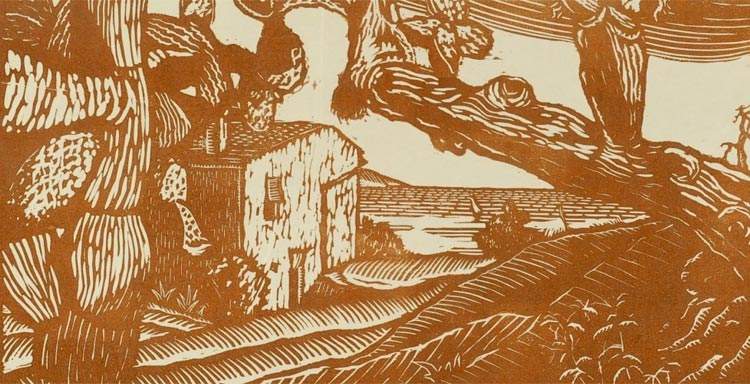From Sept. 5 to Oct. 26, the Pinacoteca Comunale “Carlo Servolini” in Collesalvetti (Livorno), in the Villa Carmignani venue, is hosting the exhibition Luigi Servolini and Frank Brangwyn at the Time of Eroica. Moments of the Rebirth of Woodcut between Italy and England, organized and promoted by the Collesalvetti Municipality, on the occasion of the Collesalvetti Fair, conceived and curated by Francesca Cagianelli. Determined to continue and amplify the multi-year exhibition path initiated with the aim of enhancing the season of the two Servolini artists in the light of an increasingly in-depth and articulate cultural dialogue with Europe, the Collesalvetti municipal administration is aiming this time at the artistic relationship that existed between Luigi Servolini (Livorno, 1906 - 1981) and the British painter and engraver Frank Brangwyn (Bruges, 1867 - Ditchling, 1956).
While it is true that in the volume La Xilografia (Arnoldo Mondadori Editore 1950) Luigi Servolini celebrated Frank Brangwyn among the most deserving interpreters of the rebirth of the genre of color woodcut in England, that is, among those who "distinguished themselves, as well as by originality, by the novelty of the means by which they achieve their works, " it is in the pages of the prestigious Ligurian magazine L’Eroica that that expressive afflatus toward “the Brangwyn case” already looms large, shared not only by editor Ettore Cozzani, but also in all likelihood by those who, like the Leghorn woodcut artist, were co-opted there during the 1920s.
It is no coincidence that the room reserved for Brangwyn’s engravings published in the 1919 special issue of L’Eroica dedicated to England dominates the exhibition itinerary of the Colligiana exhibition, within which a programmatic editorial illustrates the reasons for the British artist’s fortune in Italy, with reference to his art as “a typical expression of modern English sensibility and technical galliance,” whose xylographic outcomes result in “a sign of his great passion for our land and our culture.” Brangwyn’s popularity in Italy is thus identified in the latter’s ability to interpret excellently and modernly its “natural wonders,” the “mystery of its historical memories,” the “tragic immensity of its cataclysms,” but above all to convincingly restore its “youthful impulse of life” and “dazzling desire to rise to the noble conquest of a future worthy of its past greatness!” The main objective of L’Eroica thus remains to celebrate “the creator of a thousand visions of dramatic grandeur and powerful beauty,” as well as, of course, "the friend of our homeland and our generation, “ that is, the one who even fulfilled the commitment to reveal Italian art in England, as in the case of the organization of the Exhibition of Contemporary Italian Engraving.”
With the precious woods donated as a preview toEroica, Brangwyn also wanted to participate in the battle for the rebirth of woodcut by transfusing into an engraving branch he had never practiced so far a flash of his imagination and the throb of his faith.
It will be the Triestine Ermanno Viezzoli, an unstoppable promoter not only of the work of Vittore Grubicy de Dragon, but also of the artistic parabola of the Leghorn-born Benvenuto Benvenuti, who will attempt to unravel in the course of some of his publishing ventures that “way of the Infinite” traceable to Brangwyn’s expressive universe, reaffirming in the Italian venue the “act of faith” to the English artist, considered nothing less than “the dominant profile of the contemporary artistic panorama.” The overview offered by the Colligiana exhibition of Luigi Servolini’s xylographic production (on display are thirty-two engraving masterpieces lent by the Livorno Foundation) at the time of his collaboration with L’Eroica, but also in the following decade, is intended to acknowledge that admiration for the experimentation with the extreme virtuosity of xylographic practice enacted by Brangwyn and shared by a large group of twentieth-century xylographers.
Hours: through Oct. 26, every Thursday 3:30-6:30 p.m. Sept. 9 through Oct. 1: Saturdays and Sundays 3:30-6:30 p.m. Free admission, guided tours by appointment for individual groups: 0586-980251/252 and 392 6025703.
Image: Luigi Servolini, Prickly Pears in Portoferraio, detail (1936; woodcut; Livorno, Livorno Foundation)
 |
| An English engraver in early 20th century Italy: the exhibition on the relationship between Bragwyn and Servolini |
Warning: the translation into English of the original Italian article was created using automatic tools. We undertake to review all articles, but we do not guarantee the total absence of inaccuracies in the translation due to the program. You can find the original by clicking on the ITA button. If you find any mistake,please contact us.